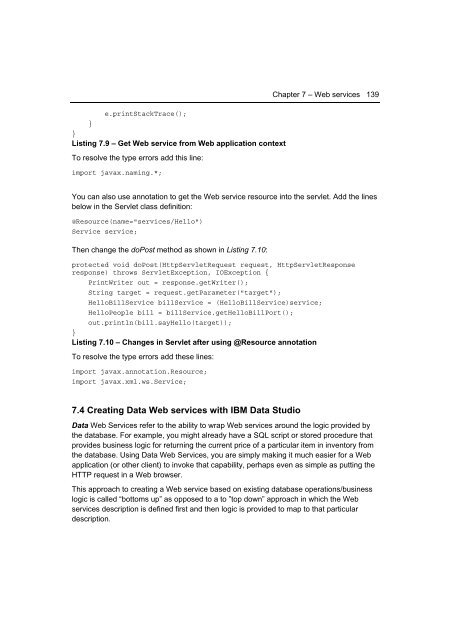Getting Started with WebSphere Application Server
Create successful ePaper yourself
Turn your PDF publications into a flip-book with our unique Google optimized e-Paper software.
Chapter 7 – Web services 139<br />
e.printStackTrace();<br />
}<br />
}<br />
Listing 7.9 – Get Web service from Web application context<br />
To resolve the type errors add this line:<br />
import javax.naming.*;<br />
You can also use annotation to get the Web service resource into the servlet. Add the lines<br />
below in the Servlet class definition:<br />
@Resource(name="services/Hello")<br />
Service service;<br />
Then change the doPost method as shown in Listing 7.10:<br />
protected void doPost(HttpServletRequest request, HttpServletResponse<br />
response) throws ServletException, IOException {<br />
PrintWriter out = response.getWriter();<br />
String target = request.getParameter("target");<br />
HelloBillService billService = (HelloBillService)service;<br />
HelloPeople bill = billService.getHelloBillPort();<br />
out.println(bill.sayHello(target));<br />
}<br />
Listing 7.10 – Changes in Servlet after using @Resource annotation<br />
To resolve the type errors add these lines:<br />
import javax.annotation.Resource;<br />
import javax.xml.ws.Service;<br />
7.4 Creating Data Web services <strong>with</strong> IBM Data Studio<br />
Data Web Services refer to the ability to wrap Web services around the logic provided by<br />
the database. For example, you might already have a SQL script or stored procedure that<br />
provides business logic for returning the current price of a particular item in inventory from<br />
the database. Using Data Web Services, you are simply making it much easier for a Web<br />
application (or other client) to invoke that capability, perhaps even as simple as putting the<br />
HTTP request in a Web browser.<br />
This approach to creating a Web service based on existing database operations/business<br />
logic is called “bottoms up” as opposed to a to ”top down” approach in which the Web<br />
services description is defined first and then logic is provided to map to that particular<br />
description.

















